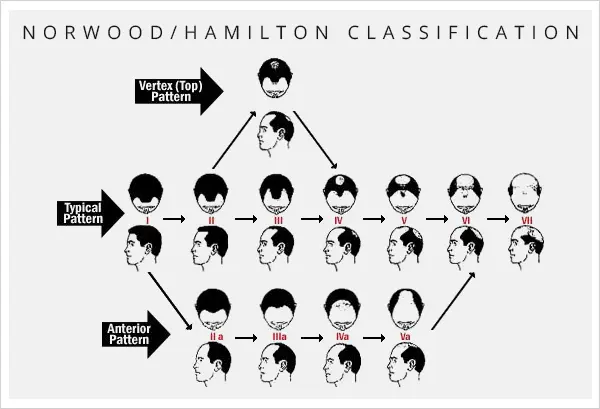Male Pattern Baldness
Male pattern baldness doesn’t have to define you. Take control of your confidence with expert solutions from Pizarro Hair Restoration.
Male pattern baldness has been responsible for the vast majority of hair loss in men.
Male pattern hair loss, known scientifically as androgenetic alopecia, is a widespread issue impacting many men worldwide. In the United States alone, nearly two-thirds of men at age 35 suffer from receding or thinning hairline. By the time they reach 50, approximately 85% of them get affected by male pattern baldness in their lifetime.
At Pizarro Hair Restoration, we believe in the importance of early intervention to counter male pattern baldness. Our approach encompasses both proactive measures to save your natural hair and retroactive techniques to restore your fuller head of hair. Using cutting-edge tools and techniques, we’ll help address male pattern hair loss effectively.
Causes and Signs of Male Pattern Baldness
The main culprit behind male pattern baldness is the hormone known as dihydrotestosterone (DHT). DHT is an androgen that influences vocal deepening, body fat distribution, muscle changes, and hair growth. Men sensitive to DHT produce less hair, resulting in thinning hair and even baldness.
While the causes of male androgenetic alopecia (MAA) are associated with hormonal changes, various other factors can also contribute to this condition. These include:
- Poor nutrition
- Certain Illnesses
- Reaction to Strong Medications
- Stress
- Aging
About 25% of men who suffer from MAA begin the painful process before they reach 21. They may gradually experience symptoms such as:
- Receding Hairline, Usually Starting at the Temples
- Thinning of the Hair on the Crown of the Head
- Formation of Bald Spots or Patches.
Diagnosing MAA centers around the pattern of hair loss, as well as underlying health problems, fungal scalp issues, or nutritional imbalances. Severe health conditions are usually suspected when hair loss coexists with symptoms such as a rash, redness, pain, scalp peeling, hair breakage, patchy hair loss, or an unusual hair thinning pattern.
7 Stages of Male Pattern Baldness
Male pattern baldness presents itself in seven distinct stages, each manifesting differently in every individual. At Pizarro Hair Restoration, we use the Norwood scale to gauge the extent of your hair loss. This helps us create a personalized treatment plan that works best for your condition:
- Stage 1 - This initial stage features a full head of hair with minor hairline recession or slight crown thinning. This hairline pattern is common during the teenage and early adulthood years before male pattern baldness becomes more prominent.
- Stage 2 - Characterized by a triangular recession near the temples, relatively mild but still evident hair loss can be observed during this stage.
- Stage 3 - In this phase, hairline recession becomes more pronounced, forming a distinct M or V shape. Hair around the temples becomes minimal or absent.
- Stage 4 - Stage 4 is marked by more substantial hair loss. Individuals at this stage may have sparse hair or even complete baldness on the crown or vertex of the scalp.
- Stage 5 - Progressing into stage 5, a dense band of hair separates the receding hairline from the thinning area, which continues to shrink over time. Hair loss is readily apparent at this stage.
- Stage 6 - During this stage, hair loss is notably severe. Sparse, thin, or absent hair characterizes most areas around the hairline, vertex, and crown.
- Stage 7 - Stage 7 represents the most severe hair loss. Very little to no hair remains on the scalp, leaving a significant bald area.
How Pizarro Hair Restoration Helps with MPB or MAA
At Pizarro Hair Restoration, we encourage our patients never to feel ashamed of discussing their situation and pursuing treatment. Guided by the expertise of our hair restoration specialist, we’ll help you find optimal solutions for achieving fuller hair. Here’s what we offer:
1. Personalized Treatment Plan
Our team designs treatments based on every patient's needs and goals. We'll consider your medical history, current condition, and desired outcomes to create a personalized plan that boosts the result of your hair restoration.
2. Comprehensive Hair Restoration Procedures
Whether you're interested in non-invasive treatments or more advanced surgical options, we'll give you access to the most suitable and effective methods for restoring your hair.
3. Premium Hair Restoration Products
We offer a selection of premium hair restoration products that have been carefully curated to nourish the scalp, strengthen hair follicles, and encourage natural hair growth. Incorporating these products into your routine can enhance the success of your hair restoration.
4. Expert Guidance and Counseling
Having the right guidance is essential when addressing male pattern hair loss. With her extensive experience and remarkable track record, Dr. Pizarro is here to help you understand your situation and recommend the best treatments for you.
Frequently Asked Questions
Male pattern baldness has a genetic component, so prevention isn't always possible. However, maintaining a healthy lifestyle, managing stress, and using hair care products that support scalp health may slow its progress.
Yes, chronic stress can contribute to hair loss, including male pattern baldness. Stress can disrupt the hair growth cycle, leading to increased shedding and thinning of the hair.
Over-the-counter treatments typically include topical solutions like minoxidil, while prescription treatments might involve medications like finasteride. Prescription treatments often have a higher potency and require consultation with a healthcare provider.
Minoxidil promotes hair growth by increasing blood flow to the hair follicles. Finasteride, on the other hand, inhibits the production of dihydrotestosterone (DHT), a hormone linked to hair loss. It's known to slow down the balding process.
Common side effects of minoxidil may include scalp irritation, and finasteride might lead to sexual side effects in a small percentage of users. Consult our hair restoration specialists for personalized guidance.
Yes, hair transplant surgery can effectively restore hair in areas affected by male pattern baldness. Healthy hair follicles are transplanted from one area of the scalp to another.
The results of hair restoration procedures are generally permanent. After your procedure, the transplanted hair follicles will continue to grow and behave like natural hair.
Poor diet, smoking, and excessive alcohol consumption can potentially worsen the progression of male pattern baldness.
Wearing hats or using hair products is unlikely to directly cause male pattern hair loss. However, excessive tension from tight hairstyles might contribute to hair breakage.
Consulting a dermatologist or healthcare provider is the best way to determine the cause of your hair loss. They can perform tests and evaluations to provide an accurate diagnosis.
A balanced diet rich in vitamins and minerals can support overall hair health, but dietary changes alone may not prevent male pattern baldness.
Mild cases of male pattern hair loss might respond to topical treatments like minoxidil, but more advanced cases often require a combination of treatments.
Our hair restoration specialist will assess your hair loss condition and medical history during a consultation and discuss potential treatment options tailored to your needs and goals. We'll provide information about the overall process, expected outcomes, and any associated costs.





